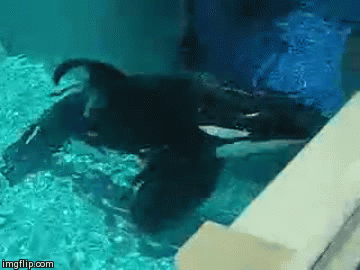In Brazil, restrictions and standards exist that make it nearly impossible for businesses to keep highly intelligent dolphins and whales like orcas and belugas in captivity.
But in the U.S., it’s a different story. The intelligent, social ocean animals kept in the pitifully small tanks at SeaWorld are denied everything that is natural and important to them. In the wild, orcas can swim up to 160 kilometers a day and other dolphins 96 kilometers per day in the open ocean, but captive whales and dolphins are confined to small tanks in which they can do nothing but swim in circles or float listlessly, and the reverberations from their sonar bounce off the walls, driving them insane.
Marine parks teach all the wrong lessons: that it is acceptable to imprison animals, deprive them of freedom of movement and thought, forbid them the chance to establish their natural territory and explore, watch them go insane from boredom and loneliness, and breed and separate them as we please.
Here are 13 reasons why you should skip SeaWorld on your visit to Orlando, Florida:
1. Orcas Were Kidnapped From Their Homes and Sent to SeaWorld
Five orcas currently at SeaWorld were kidnapped from their ocean homes, as were others who have since died. For example, Tilikum, a 34-year-old orca, was captured at the age of 2 by a marine “cowboy.” He was torn away from his family against his will and confined to a small concrete tank for a hefty profit.

2. Some of the Orcas Who Were Not Captured Were Murdered
In 1965, the first-ever orca show at SeaWorld was performed by a female orca named Shamu at SeaWorld San Diego. During Shamu’s capture, her mother was shot with a harpoon and killed before the young orca’s very eyes by a marine “cowboy” named Ted Griffin. Griffin’s partner, Don Goldsberry, later worked for SeaWorld and was assigned to bring orcas into the park. He continued kidnapping, and at one point, he hired divers to slit open the stomachs of four orcas, fill them with rocks, put anchors around their tails, and sink them to the bottom of the ocean so that their deaths would not be discovered.

3. The Animals Suffer in Cramped, Unnatural Living Conditions
SeaWorld confines orcas, who could swim over 160 kilometers a day in the wild, to tanks that, to them, are the size of a bathtub. They would need to swim 1,208 laps (around the perimeter of the tank) or 3,105 lengths (back and forth at the longest part of the tank) in the park’s largest tank to equal what they’d swim in the wild.

4. Orcas in the Wild Don’t Kill People, but at SeaWorld, They Do
In the wild, despite centuries of sharing the ocean, there has never been a single reliable report of an orca attack on a human being. But SeaWorld’s corporate incident log contains reports of more than 100 incidents of orca aggression at its parks. After being deprived of everything that is natural and important to them, orcas in captivity have attacked and killed four humans since 1991.
5. Orcas Don’t Live As Long in Captivity
Orcas in the wild have an average life expectancy of 30 to 50 years—their estimated maximum life span is 60 to 70 years for males and 80 to more than 100 for females. The average age of the orcas who have died at SeaWorld is only 13.

6. SeaWorld Fails to Care for Animals Properly and Doesn’t Protect Them
The U.S. Department of Agriculture issued an official warning to SeaWorld after an animal drowned in one of its tanks because of the marine park’s failure to provide drain covers, cited the park for several violations of the Animal Welfare Act (the result of an investigation that took place after a young girl was bitten by a dolphin), and concluded that tanks in the park were in such a state of disrepair that they posed a threat to the health and safety of both the animals and workers.

7. Collapsed Dorsal Fins Are Not Normal
In captivity, all male orcas have collapsed dorsal fins as adults. SeaWorld claims that this condition is common and natural. However, collapsed dorsal fins are caused by the unnatural environment of captivity and are rarely seen in the wild. In nature, only 1 to 5 percent of male orcas in some populations (and none in others) have fully collapsed dorsal fins, and those have often been the result of injury.

8. Trainers Sexually Stimulate the Orcas to Collect Sperm
In nature, orcas choose their own mates. But at SeaWorld, they are forced to breed on a regular basis. Male orcas are trained to float on their backs, and their trainers sexually stimulate them to collect their sperm. Females are artificially inseminated and forced to breed at a much younger age than they would in nature.

9. Their Sunburns Are Covered Up With Black Zinc Oxide
Orcas at SeaWorld spend much of their time at the surface of the water with little to no shade from the hot blistering sun. In the wild, orcas spend up to 95 percent of their time submerged and would find shade in the depths of the ocean, but at SeaWorld, the tanks are far too shallow. The deepest tank is 12 meters deep—not nearly deep enough to give them a reprieve from the harsh elements. Former trainers have reported that because of this, orcas have perpetual sunburns, which are shielded from the public eye with the help of black zinc oxide, which matches their skin.

10. The Trainers Are Performers, Not Scientists
Contrary to popular belief, trainers often have no formal education in marine biology. Their main purpose is to entertain and put on a “good” show for visitors, not educate people about the intelligence, social nature, or natural families, foraging behavior, and habitats of the animals held at SeaWorld.

11. The Orcas Are Not Placed in Compatible Groups, and They Fight One Another
Orcas who are not compatible are forced to live in tight quarters together. The resulting anxiety and tension can cause fights between orcas. In the wild, orcas have strong social bonds that may last for life, their social rules prohibit serious violence against each other, and when fights do occur, they can simply swim away from each other. In captivity, there’s nowhere for them to go, which leads to injuries and death.

12. Animals Break Their Teeth in Frustration
Because of stress, anxiety, and boredom, orcas in captivity gnaw at iron bars and the concrete sides of the tanks, often breaking their teeth. In an attempt to prevent them from dying from an infection, SeaWorld employees often drill holes into the pulp cavities of broken or worn teeth in order to open them enough to be flushed and cleaned daily for the rest of the animal’s life. This has historically been done without sedation and is very likely to be painful. This type of dental trauma and wearing of the teeth is highly uncommon in orcas living naturally in the wild.

13. Families Are Torn Apart
Orcas are highly social animals who live in stable social groups ranging from two to 15 individuals. In some populations, children stay with their mothers for life. In captivity, orcas are forced to live with orcas from other family units who likely speak a different dialect from them and are constantly moved between tanks—and sometimes other facilities—for breeding and to perform. SeaWorld has routinely separated mothers from their offspring, sending the calves to various parks around the world and leaving the mothers crying out in heartbroken sadness.

Don’t Go to SeaWorld if You Care About Animals!
SeaWorld presents itself as a family establishment full of fun “educational” activities. However, these activities harm animals physically and emotionally. SeaWorld has the financial means and ability to create coastal sanctuaries, where the orcas would have a more natural and less stressful life and where they could feel the tides and waves; see, sense, and communicate with their wild relatives and other ocean animals; and have the opportunity to engage in other natural behavior, which they are now denied. However, the park instead chooses to stick with the same inhumane business model that it has used for 50 years, despite all the violent and deadly incidents and evidence of harm. Please say NO to SeaWorld and its enslavement of animals by refusing to buy a ticket.




